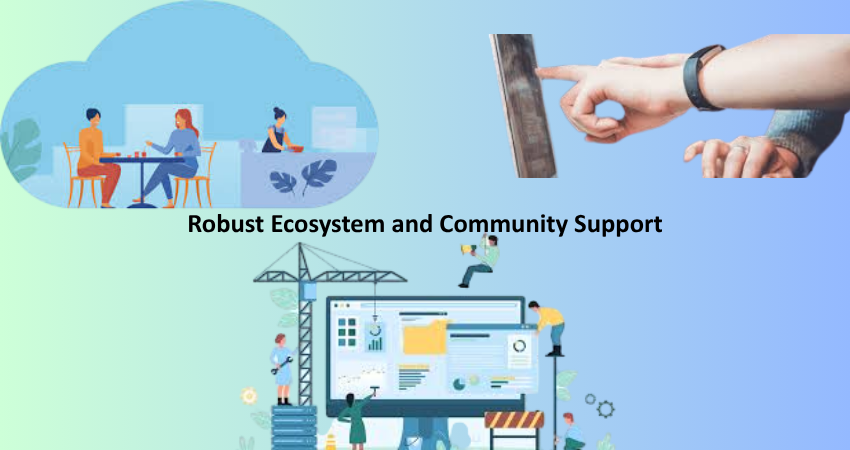
Introduction
Backend development is such a fast-changing phenomenon, and choosing the right programming language to build APIs is most crucial for performance and scalability. Well, a language that has gained considerable popularity among developers, especially those into Api and microservices, is Go-also called Golang. Go is a statically typed compiled programming language developed by Google and released in 2009. Although it is known for its simple syntax, efficiency, and performance, over the years, Go has become a darling for backend engineers with the aim of fast, concurrent, and maintainable systems.
Go was created for addressing a large part of the traditionally server-side development pains such as slow build speeds, overly complicated code bases, and inefficient concurrency models. Its extremely minimalist syntax combined with a very powerful standard library renders it a desktop productive language without sacrificing speed or flexibility. All these features will be even more crucial regarding building backend APIs. RESTful services, gRPC servers, or real-time APIs can all be backed by Go, which proves to be a practical yet performant solution. In this article, we explore several important reasons for choosing Go for your next backend API, explaining precisely why it trumps many alternatives in key areas-speed, simplicity, concurrency, and scalability.
Performance and Speed as Core Strengths
Compiled Nature and Execution Speed
One of the most famous features of Go is its compiled nature, which ultimately translates into better performance. In contrast to interpreted languages like Python or JavaScript (Node.js), Go is in fact compiled all the way down to machine code. As a consequence, Go programs run very fast, often achieving speeds comparable to C or Java. This is especially advantageous for backend APIs where speed is really an essence, considering the heavy load conditions. APIs should be able to handle thousands or even millions of requests in a single day, and just a couple of milliseconds less per call means a huge difference in their throughput and user satisfaction.
Furthermore, the compilation process is made fast for the language Go. Developers do not have to wait for minutes even for huge applications to compile but almost all go applications compile within seconds. This speeds up development cycles without bringing about switching of context and makes creating iterations very easy. The other thing is that in Go, binaries are spartan, able to run without a virtual machine or with no other dependencies. This further reduces the startup time and enhances deployment, which are key factors for APIs that will scale horizontally over cloud instances or containers. In short, Go legitimately participates in the performance contest: execution speed and lightness make Go worthy of consideration for any performance-critical backend API.
Memory Management and Garbage Collection
Backend memory management especially for APIs, is critical because they have to run for a longer time and handle extensive simultaneous traffic. Go brings to the table beautiful solutions to automatic garbage collection and memory management. The enhancements that have gone into the garbage collector over the years have reduced its latency and increased throughput. This makes Go most suitable for server-centric applications, which must obtain the same output performance consistently over time. In contrast to some languages, where garbage collection might lead to gaps sometimes close to feature tuning, Go is embedded such that it remains almost imperceptible in any well-designed application.
Unlike some modern shells, Go does offer memory footprint predictability based on its ease of stated memory model, an essential aspect in highly constrained resource environments such as containerization. You can do without manual memory allocation and won’t have the constant worry over buffer overflows and memory leaks as with C or C++. That isn’t to say Go doesn’t give enough control when optimizing memory use. Automation and control balance allows your API to run at optimal performance under pressure, without constant memory profiling and debugging efforts. Go’s memory management gives an advantage while creating APIs that need to be robust, fast, and resource-efficient.
Concurrency and Scalability

Goroutines and the Concurrency Model
Concurrency is among the primary characteristics that define Go, as one of the key factors responsible for its design as a perfect language for backend APIs. Lightweight threads called goroutines make Go super easy when it comes to running multiple operations at the same time, exhibiting less than minimal memory-performance overhead. Unlike threads in Java or Python, goroutines have become super cheap in terms of memory and performance. You can fire up a few thousand, millions of goroutines, and hardly feel any performance penalties associated with the traditional multi-threaded models. This is what makes Go a natural choice for APIs that need to handle multiple requests in parallel or maintain multiple client connections concurrently.
It’s Go’s scheduler and channels that hold the magic in Go’s concurrency model, which permits safe communication among goroutines. Go’s way of looking at concurrency is so simple that it does not require the complications of tricky lock mechanisms or callbacks that most other languages use to make – and often break – concurrency. Here, sharing data and completing tasks across goroutines is managed with the help of channels, thus allowing developers to design both highly scaled and maintainable concurrent systems. By building your backend API in Go, you are inherently endowed with a modern concurrency model that has been designed to scale tasks in a super-efficient way, reduce latency, and substantially improve the responsiveness of your application.
Ideal for Microservices Architecture
Microservices now have become acknowledged architecture pattern for building scalable backend systems in today’s cloud-native development ecosystem. Go is well suited for delivering microservices based on its lightweight design, fast startup time capability, and high throughput under load. Microservices architecture is composed of deploying many small services, each performing one small task. These services must be able to directly relay information to one another, in a reliable and speedy way, often using APIs. Because of high efficiency and good concurrency, Go becomes a well-fitted language for making and managing API-driven services. Most importantly, it can compile down to self-contained static binaries, making it easy to containerize with Docker or orchestrate with Kubernetes.
In the process, goind can actually compile to self-contained static binaries; it can, therefore, easily get containerized as well as orchestrated with Kubernetes. Each micro-service can then be captured into a portable Docker image with minimal dependencies that results in faster deployments and easier scaling. Go also supports modern API protocols such as REST, gRPC, and GraphQL, giving teams the choice to utilize this depending on their preferences. With a good mix of simplicity, performance, and concurrency, not only does Go fit into the microservices landscape, it also acts as an enabler. Go is a bit on the expensive side as it provides a good toolset that allows effortless growth for teams who are applying or enhancing their microservices architectures.
Developer Productivity and Code Maintainability
Minimalistic and Readable Syntax
Perhaps one among the most refreshing aspects of Go is its minimalist syntax. Clear and simple, the language has been designed with ease of reading and writing in mind. Rather than allowing multiple methods for performing the same task, Go emphasizes convention over configuration, promoting uniformity across the code base, which is in turn easy to navigate by new developers. There is an almost clear “Go-way” of doing things, minimizing confusion and encouraging best practices across teams. API building and maintaining-turns out to be a long-term-project, but consistency becomes a big-time productivity booster.
Furthermore, Go is a language that gets rid of features that serve no purpose but to clutter the code, like inheritance and generic programming (the latter being introduced very carefully in Go 1.18 so as not to compromise clarity); Go encourages the use of clean interfaces, simple function definitions, and predictable behaviors. The simplicity not only shortens the learning curve for any new developer but also facilitates collaboration among teams. In the long run, it does mean fewer bugs and less technical debt. More neatly structured and syntactically simple, Go is especially suited for stability and maintainability in API development and this enhances faster people onboarding, quicker feature development, and more solid code.
Built-in Tools for Testing and Documentation
Go is accompanied by a powerful internal suite of tools that simplifies the tasks of developing, testing, and documenting. Unit testing (with the testing package), benchmarking, and profiling are part of the standard library-all without having to source third-party frameworks. Integrated in this manner improves the chances for teams to enforce coverage and build robust, well-documented applications programming interfaces (APIs). Automated tests maintain their place at the core of building backend APIs to ensure the functionality of endpoints as expected and that they remain within their contracts over time. Testing tightly integrated into workflow really supports TDD and CI out of the box.
Beyond testing, Go can automatically generate documentation with a tool called godoc, which produces clean navigable documentation straight from the comments present in the code. Developers can see API docs in the browser and internally share them, thereby simplifying cooperation and maintenance. There is also go fmt, which enforces code styling and prevents wasting any time on debates over formatting during the code review process. These built-in tools have a practicality-oriented design-artfully interwoven so as not to disturb the flow of writing features for developers. For teams wanting to build and maintain high-quality backend APIs, Go tooling represents a large jump in productivity.
Robust Ecosystem and Community Support

Mature Standard Library and Third-Party Packages
The Go ships with a complete standard library which already covers almost all possible use cases-from HTTP servers to JSON parsing, templating, and cryptography. You can start building your backend APIs with the least possible dependencies, thereby creating fewer security risks and simplifying the building process. Unlike several languages, you are not dependent on third-party packages to obtain production-grade tools; Go offers all such services out of the box. The standard library is also quite well-documented, maintained regularly, and tested by the core team at Google, ensuring the necessary level of reliability and performance.
Apart from the built-in libraries, there’s a whole world of external third-party packaging and framing to supplement Go for back-end API development. Some of the lightweight and fast frameworks like Gin, Echo, and Fiber implement APIs in terms of routing, middleware, and processing of requests. Other extensions include GORM as an ORM, Go-Kit for microservices, and grpc-go for gRPC servers; all along these lines, the options are completely liberal. Libraries and templates have been bundled together by the community for extensive logging, configuration, metrics, and monitoring to streamline the development cycle. Thus, here we have almost every ecosystem to let developers develop scalable, secure, and production-ready APIs in Go.
Active Community and Long-Term Support
One of the major strengths of Go is its community. Working hand-in-hand with Google and supported by a global network of contributors, Go is evolving into the future with a sane mind and a focus on stability. It follows an announced release schedule of its own and maintains backward compatibility between versions; the latter is truly existential for the long-lived backend systems. Hence, the stability gives companies confidence that their APIs will not break due to some sudden changes in the programming language. Besides, the Go community thrives on forums, GitHub repositories, Slack channels, and conferences, creating more paths to support, best practices, and open-source tooling.
Newcomers have yet another advantage with Go: they will benefit greatly from its ease of access as most tutorials, video courses and open-source projects understand it. Consequently, it has made things easier for teams to scale, because it wouldn’t have to take very long for the newcomers to get accustomed to the language. Furthermore, all the major cloud players—AWS, Google Cloud and Azure—have crowned this language with excellent support in their SDKs and available services. This doesn’t just mean that all three giants have decided to offer Go, but it also means that everything related to it is aligned with modern DevOps practices and cloud-native infrastructures. Ultimately, community support and longevity are what count when choosing a language for backend API development—both of which Go has.
Conclusion
Choosing the correct language with which to construct backend APIs is a decision that could have historic impacts on performance, scalability, and maintainability. For Go, it is a powerful option for current API development and bestows an unparalleled speed, great concurrency model, and, like this, simplicity with which a developer can easily develop an application that is clean and scalable. Its compiled language and efficient memory management ensure that APIs run fast and lightly yet bear all the goroutines and channels, thus making concurrent system design intuitive and reliable.
Go is beyond merely the technical performance; it is also best in developer experience with a readable syntax, built-in tools, and rich community support. It succeeds at either building a single RESTful endpoint or designing a complete microservices infrastructure. Go has the necessary tools and flexibility to get things done correctly. As the backend landscape is becoming more and more performance-centric, concurrency-ready, and easily scalable, Go is of the trend but rather a solution for the longer run. For anyone building the next generation of APIs, Go is worth considering—hard to beat, to be honest.